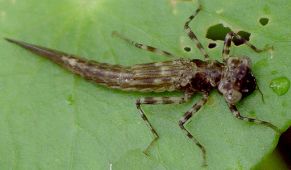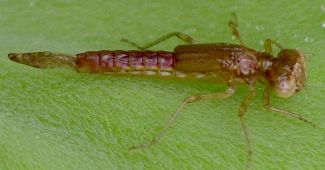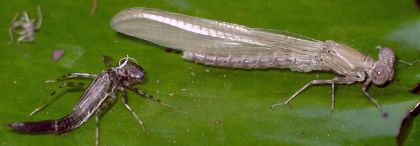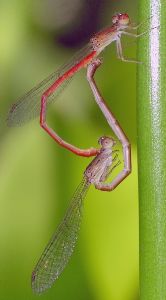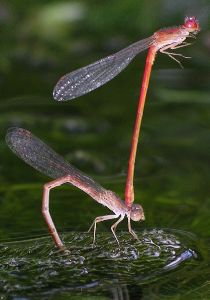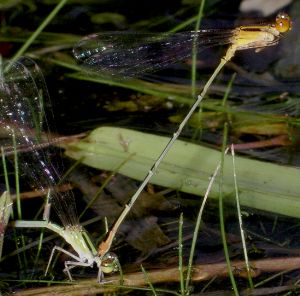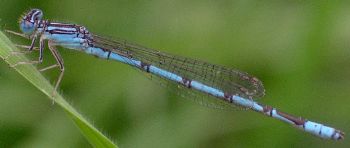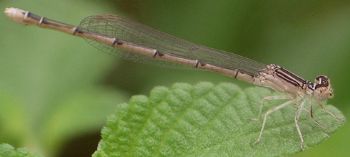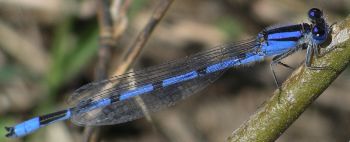
| Coenagrionidae ~ Pond Damsels |
page 1 ![]() page 2
page 2
|
Most of the damselflies found in our area belong to this large family. The pond damsels are so named because many species live in still water, even though a good number also live in flowing streams and rivers. The insects in this family are slender, on the small side, and easily overlooked. They are most often found near the ground, perching on rocks, sticks, or low-growing vegetation.
Nymphs, being aquatic, are not seen too often unless one looks for them. Just like dragonflies, these larvae are predaceous. They emerge from the water in order to molt and become winged adults. Many species' nymphs look similar, but those of the male Desert Firetail (Telebasis salva) actually have a red color even before they emerge.
It is not uncommon to see damselflies molting at the edge of water. It's just that the small size of the insects makes them likely to go unnoticed, no matter how numerous they are. They usually crawl just a short distance out of the water, frequently clinging to vegetation. Once the adult emerges, its body and wings both must lengthen and dry out. The whole process can be watched and usually takes under an hour. Damselflies can often fly weakly before their wings are fully dried, but they will only do so if they feel threatened.
The Desert Firetail makes a good example for damselfly mating and ovipositing. This tiny species is quite common in small garden ponds and is easy to observe. The male must transfer sperm from the tip of his abdomen to the base, where it is placed in a special structure. He then uses clasping appendages on the tip to hold the female behind the eyes. She then bends her abdomen forward to receive the sperm. The resulting connected insects are then in the "wheel position" which is common to all odonates. They can fly like this, but usually just cling to vegetation.
Many species, including the Desert Firetail, remain connected even after mating. The male still holds onto the female's neck, but sticks up straight while she lays eggs. This particular species lays eggs just under the water's surface, but some damselflies actually crawl underwater to lay their eggs farther down. The male may then release the female rather than be dragged underwater too, but some actually keep holding on. This guarding not only keeps the female from mating with another male, but if a predator comes by, it will more likely grab the exposed male, thereby protecting the female in a sort of decoy-like manner.
The abdomen of a female pond damsel is almost always a little thicker than that of a male, and the tip of the abdomen as well as the base show the structures that differ between the two sexes. Although their sizes might be similar, the colors of the males and females are often quite distinct. The Desert Firetail (Telebasis salva) males are bright red while the females are much more dull in color. The males are rather territorial and will chase other males away from their small patch of prime pond real estate. The tiniest damselfly in our area, at about 25 mm, is the Citrine Forktail (Ischnura hastata). These little insects are nearly invisible in the grass and I've only seen males, although I'm sure the females are around too. The name comes from the bright yellow abdomen. Other identification features are the green head and thorax with a good deal of black on top (even the tops of the eyes are black!) and the little red/white/black marks near the tips of the wings. These wing markings are unusual, and different from any other damselfy.
A similar species, albeit a bit larger, is the Fragile Forktail (Ischnura posita). I've also not seen many of these, and only the male has come to my attention. Like the Citrine Forktail, this damsel has a green thorax and yellow abdomen. However, there is much more black on the top of both, especially on the abdomen. The feature that is easy to see, though, is the unusual marking on each side of the top of the thorax. Instead of the usual light stripe in the black part, the Fragile Forktail has a partial stripe and a spot, which looks like an exclamation mark. There is one more species in this genus and it is by far the most common in our area. Rambur's Forktail (Ischnura ramburii) is perhaps the single most commonly seen damselfly around many small ponds. This damsel illustrates a widespread trait among pond damsels, in that the male comes in one color form while the female comes in three different ones. Like the other two forktails, Rambur's Forktail has black on the topside, including the upper part of the eyes. The male has a green head and thorax, and a yellow abdomen with a turquoise colored tip. The black on the top of a segment near the tip is broken, so that the blue color extends across the top, making it very apparent.
One form of female is olive green, blending from dark on top to very light on the underside. Another is very similar to the colors of the male, except that the head and thorax are sky blue instead of green, and they match the abdomen tip color. Yet a third variety has an orange thorax with a black dorsal stripe. The abdomen of this one looks mostly black but is actually sort of light green on the underside. The female Rambur's Forktails seem to be very aggressive when it comes to hunting. It could just be a result of their numbers, but I have seen more of them eating prey than just about any other species, and have even seen a female eat a male. They can also be found mating near ponds, and the different color combinations are delightful.
One of the larger genera of pond damsels is Enallagma, commonly called the bluets. In spite of the number of species, there are only a handful in our area. One species that occurs here but that I've never seen is the Orange Bluet (Enallagma signatum). I suspect one reason I've not encountered this one is that I rarely spend time outdoors in the late afternoon, especially during the summer when it is so hot. Since I'm a morning person, I never run into "afternoon" animals, and that is exactly what the orange bluet is. I have seen these in a pond near Dallas, and they were quite common in the late afternoon, flying about, mating, and ovipositing. As might be expected from the name, the Orange Bluet is not blue. Males have an orange head and thorax, as well as the tip of the abdomen. The main part of the abdomen is more bluish. Black markings on the top include stripes on the thorax and on the top of each abdominal segment. Females are greenish. Species in the genus Enallagma can sometimes be mistaken for those in the genus Argia (the dancers). There are a few ways to distinguish them, including the manner in which they hold their wings. Bluets tend to rest with their wings down over the abdomen, while dancers more often hold theirs up above their abdomen. Of course, there are exceptions, but this habit can sometimes be quite useful in identification. Another feature that is not a hard and fast rule but more of a tendency is the presence of a horizontal stripe on the eyes of bluets. Occasionally, dancers will also have a vague horizontal reflection on their eyes, but mostly they are unmarked. Our two most common species of bluets are smaller than similar species of dancers, but without side-by-side comparison, this is not always easy to judge.
All that said, one species I find occasionally is the Double-striped Bluet (Enallagma basidens). This is a very small damsel, which can easily go unnoticed in grass in spite of the male's bright aqua color. The females are brown. The best way to recognize this damsel is by the thoracic stripes, which include a pair of very closely spaced black lines on the upper sides. Both the male and female have these.
By far the most common species of the genus, the Familiar Bluet (Enallagma civile) is sometimes encountered at the same time and places as the Double-striped Bluet. This damsel is a bit larger, and so can more easily be mixed up with some of the blue dancer species. Close attention must be paid to the black markings. Males are blue, but may be either intense blue, light turquoise, or a sort of purplish blue. Females may be brown or a brown and blue combination, with longer black dashes on the tops of the abdominal segments than the males. The thorax in both sexes is quite hairy. While this detail is difficult to see with the naked eye, the fine hairs often reflect sunlight and so show up well in photos.
|
page 1 ![]() page 2
page 2
![]()
